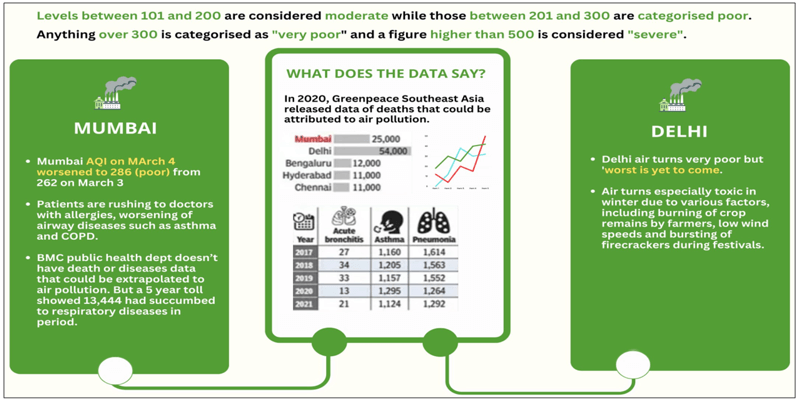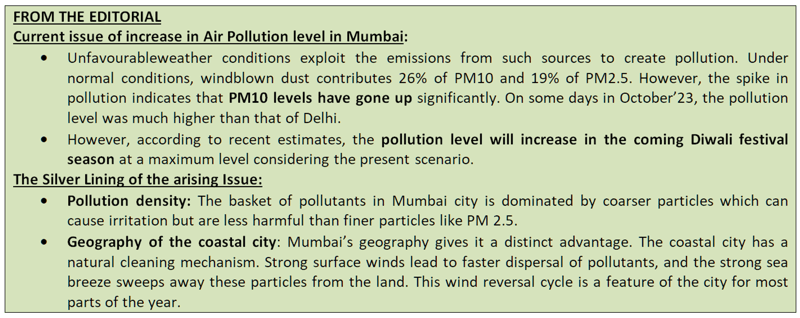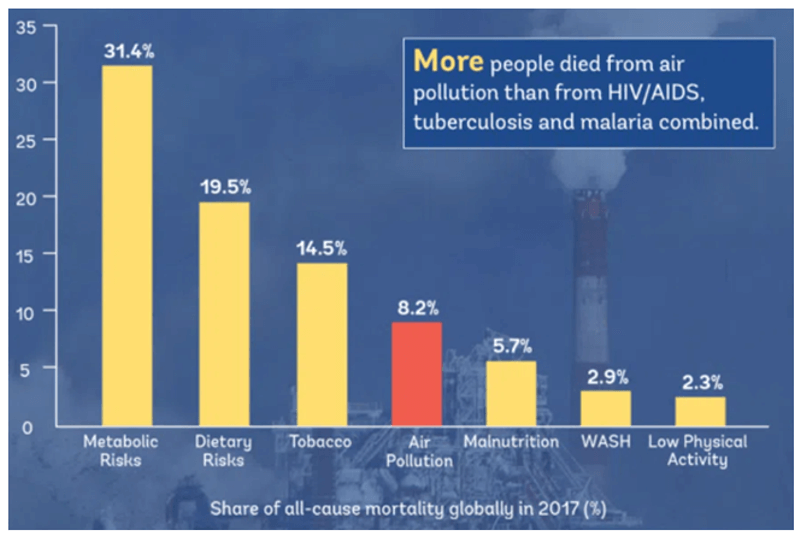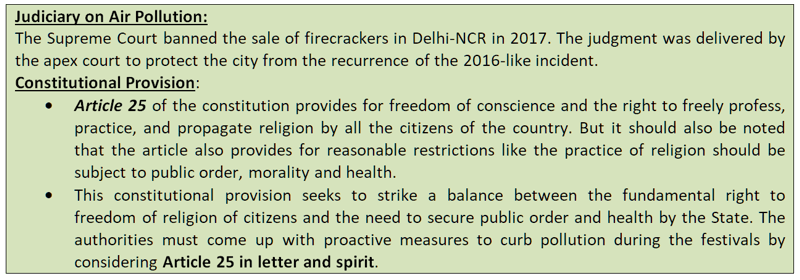Increasing Air Pollution in Urban India
Relevance: GS III (Environment and governance)
- Prelims: IQAir Report; Air Pollution in Indian Cities;
- Mains: Urban Air Pollution; Challenges and health issues due to Air Pollution; Government initiatives to prevent air pollution;
Why in News?
Climate Change has negated its pollution-cleansing advantage. The city needs plans for long-term control.
Background of the News:
- Over the years, there has been a massive-scale expansion in industries, population density, anthropogenic activities, and the increased use of automobiles has degraded the air quality in India.
- Delhi gets the most attention for its notoriously high pollution levels. But it has been evident for some time now that bad air problems are also affecting the other larger parts of the country.
- Mumbai has experienced an air quality crisis during the post-monsoon period for the second consecutive year. For most of October 2023 so far, the AirQuality Index (AQI) in Mumbai has registered “moderate” or “poor”. To the surprise, the city has not had a single “good” air day in October month.
 What does the IQAir World Air Quality Report 2022 say?
What does the IQAir World Air Quality Report 2022 say?
PM2.5 is particulate matter that is less than 2.5 microns in diameter and is used as the standard air quality indicator for IQAir’s World Air Quality Report.
- India’s average PM2.5 concentration, measured in micrograms per cubic meter (μg/m3), in 2022 was 53.3% – against the WHO’s recommended annual guideline level of 5 μg/m3.
- The average calculated by IQAir was also higher than the liberal standard of 40 μg/m3 set by India’s Central Pollution Control Board.
- Bhiwadi (Mumbai), which was the most polluted city in the world in 2021, came third in this year’s report. Lahore in Pakistan was the worst, according to IQAir, followed by Hotan in China. Delhi was fourth.
- There are six Indian cities in the top 10, 14 in the top 20, 39 in the top 50, and 65 in the top 100 – up from 61 in the previous year.
- The transportation sector’s contribution to PM2.5 varies from 20-35% across Indian cities, the report says, adding that stubble burning is also an important challenge.
- Central and South Asia perform poorly:
- In 2022, Central and South Asia was home to eight of the world’s ten cities with the worst air pollution.
- “According to the World Bank’s report on Air Pollution in South Asia 2022, air pollution causes an estimated two million premature deaths across the region each year and incurs significant economic costs.

Causes of increase in Air Pollution in Urban cities:
- Change in the Monsoon cycle:Withdrawal of the Monsoon season plays an important role in air pollution, especially in the Coastal season.
- La Nina Effect:La Nina has gone up this year which resulted in delayed monsoon season. An abnormal drop in surface temperature in the Pacific Ocean had a telling effect on coastal winds around Mumbai.
- Transport level winds: Thetransport level winds, much above the surface in the atmosphere, are moderately fast and blow towards Mumbai from the Sahyadri mountain ranges, around 2,040 ft above sea level. These chilly moderate winds are capable of transporting pollutants from Mumbai. When these winds started losing energy, they descended near Navi Mumbai and the surrounding coastal region where they encountered warm and dusty winds. When this dust-filled cloud is pushed towards Mumbai, it is arrested because of the calm winds, hence deteriorating the city’s air quality.
Issues related to Air Pollution in Urban India:
- Blooming of several other problems fromSingle-source: The “usual” is becoming “unusual” and getting triggered by additional anthropogenic factors – like particulate pollution which are largely related to the unusual triple dip La Nina conditionsunderstood as linked to climate change. In other words, the pollution from anthropogenic activities was not cleansed due to which the city experienced its worst air decade.
- Rising Diseases:Many toxins have disastrous effects on human health. However, the ones of most concern and that impact public health the most are carbon monoxide (CO), sulphur dioxide (SO2), nitrogen dioxide (NO2), ozone (O3), and particulate matter (PM).Household air pollution exposure leads to noncommunicable diseases including stroke, ischaemic heart disease, chronic obstructive pulmonary disease (COPD) and lung cancer.
- Rising deaths:A 2021 study said that breathing ambient air with unsafe levels of5 causes approximately four million early deaths each year, globally. Of this, 25% of deaths occur in India.
- According to WHO, It also estimates that air pollution in India is responsible for over 1.2 million deaths each year.
- Non-ability to Track efficiently: Though air quality monitoring has increased over the past years in India, the country still lacks the ability to track the progress of reduction strategies through an effective and reliable emissions inventory.


Way Ahead:
- The granular level variation and observation are needed:The government has significantly increased the number of monitoring stations but to cover a vast country like India, more ambitious and directed initiatives and regulations are required. Studies have shown that within a city block, air pollution can vary as much as eight times due to complex urban dynamics.
- This calls for the need to monitor hyper-local air pollution, that is, granular level variation observation to effectively characterize, understand, and provide the information to decision-makers in developing policies. The formulation of city action plans should be aligned with hyper-local action plans for ease in management and governance.
- Encourage Sustainable / Public Transportation: Encouraging the use of sustainable transportation options can significantly reduce pollution levels. Investing in public transportation systems, promoting cycling infrastructure, and incentivizing the use of electric vehicles can all play an important role in reducing air pollution. Carpooling and ride-sharing initiatives can help reduce the number of vehicles on the road, leading to improved air quality.
- Promote Energy Efficiency: Energy production and consumption are major contributors to air pollution. Promoting energy efficiency measures can help reduce emissions from power plants and residential buildings. Encouraging the use of energy-efficient appliances, promoting renewable energy sources, and implementing building codes that prioritize energy efficiency can all contribute to reducing air pollution in cities. By adopting sustainable energy practices, we can not only improve air quality but also reduce greenhouse gas emissions and combat climate change.
- Implement Green Spaces and Urban Planning: Green spaces, such as parks and gardens, play a vital role in mitigating air pollution in cities. Trees and plants act as natural air filters, absorbing pollutants and releasing oxygen. Incorporating green spaces into urban planning initiatives can help create a healthier urban environment.
- Promote Sustainable Construction Practices: Encourage sustainable construction practices that minimize dust and emissions during building projects. Implement measures to control construction dust, such as using water sprays, covering construction sites, and properly managing construction waste.
- Implementation of the proposed Plan and Policies: India needs to enforce the strict implementation of policies and employ granular-level technical studies to identify the real ground scenario in terms of air pollutant concentration and variability.
Addressing air pollution requires collaboration among various stakeholders, including government bodies, organizations, businesses, and citizens.By working together, sharing knowledge and resources, and advocating for stricter regulations, we can create a collective impact in reducing air pollution in cities.
 PYQs
PYQs
In the cities of our country, which among the following atmospheric gases are normally considered in calculating the value of Air Quality Index? (2016)
- Carbon dioxide
- Carbon monoxide
- Nitrogen dioxide
- Sulfur dioxide
- Methane
Select the correct answer using the code given below:
(a) 1, 2 and 3 only
(b) 2, 3 and 4 only
(c) 1, 4 and 5 only
(d) 1, 2, 3, 4 and 5
Mains:
Q1. Describe the key points of the revised Global Air Quality Guidelines (AQGs) recently released by the World Health Organization (WHO). How are these different from its last update in 2005? What changes in India’s National Clean Air Programme are required to achieve revised standards? (2021)


